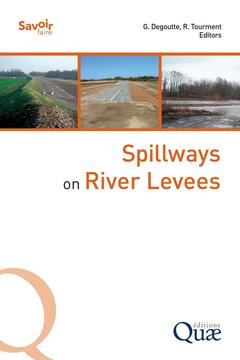Spillways on River Levees Coll. Savoir faire
Auteurs : Degoutte Gérard, Tourment Rémy

Levees are built on many rivers and mountain torrents to protect populations against floods. During medium floods, a well-constructed levee offers sufficient protection without requiring additional hydraulic structures. But this same levee represents a source of danger during high floods, since there is a risk of overtopping. Water that spills over a levee may create a breach that could potentially provoke flash flooding in the area it was supposed to protect, endangering human lives and infrastructure.
It is therefore advisable to equip levee systems with spillways, which are common appurtenant structures on dams. Yet spillways on levees play a far more complex role than those on dams, from securing protected areas to flood control. These structures can function as safety spillways or diversion spillways, or both (especially the older ones).
This technical handbook, first published in French in 2012, covers different types of spillways on river levees, including their function, hydraulics, river morphology, civil engineering, and flood management. Written by a working group led by INRAE, it is intended for levee managers, control authorities, engineering firms, and hydraulics or civil engineering students. Given increasing international interest in levees and flood protection systems, particularly following ICOLD’s creation of a Technical Committee on Levees, INRAE decided to update and translate this guide into English to share the French experience.
Foreword
Introduction
1. Background, definitions, various configurations
Typology of flood protection levees on rivers
Protected areas and flood expansion areas
Typology of spillways on levees
2. The historical background of spillways in France
1584 to 1891: The first spillway constructions on the Loire and Vidourle Rivers
20th century: Several scattered constructions and major development of the Rhône River
21st century: A relative acceleration in construction
3. The hydraulic design of spillways
The spillway’s impact on the flooded river’s waterline
Impact of the spillway on the waterline in the protected area
The spillway’s flow law
Spillway location
Protection, safety, and danger floods
The principle of flood attenuation or flood hydrograph flattening
General hydraulic design principles
The required modelling
4. Spillways and river geomorphology
Overview of sediment transport
Overview of morphological changes in watercourses
Morphological changes in leveed watercourses
The spillway’s influence on sediment transport (riverbed)
Sedimentation behind spillways
The influence of bed change on spillway performance
Torrents
5. Civil engineering design for levee spillways
Safety criteria for levee spillways
Principles of fuse plugs or movable devices
The plan shape of the levee spillway
Types of straight weirs and constituent materials
Fuse plugs or movable devices
Continuous maintenance tracks
Overflow erosion on earthen levees
6. Emergency management of the levee system
The benefits and limitations of spillways in emergency management
The types of emergencies to manage
Considerations before drafting an Emergency Management Plan
Emergency management and levee managers
Local Emergency Action Plan (LEAP)
Special Emergency Management Plan for Flooding
7. Economic aspects
8. Summary and Conclusion
The benefits and limits of a spillway in a protected area
Spillway features
Is a spillway always required in a protected area?
Concluding remarks
Appendix 1. Spillway types on river levees, according to their hydraulic function and their purpose in flood management
Appendix 2. A history of spillways on the Loire River
Appendix 3. Overflow levees and spillways in the CNR’s Rhône River development
General principles
Example 1: The Chautagne plain and Lac du Bourget
Example 2: The Printegarde plain in Livron-sur-Drôme
Glossary
Reference List
Rémy Tourment is a civil engineer, chairman of the Technical Committee on Levees within the International Commission on Large Dams (ICOLD) and Vice-President of the Comité français des barrages et réservoirs (National Dams Committee associated with ICOLD). They have both dedicated their careers at INRAE to research, teaching, expertise and auditing activities in the field of hydraulic structures, dams and levees, and river morphology.
Gérard Degoutte is an engineer in the Corps des ponts, des eaux et des forêts (France’s Bridges, Waters and Forests Corps) and member of the French Standing Technical Committee for Dams and Hydraulic Works.
Date de parution : 10-2021
Ouvrage de 176 p.
16x24.1 cm



